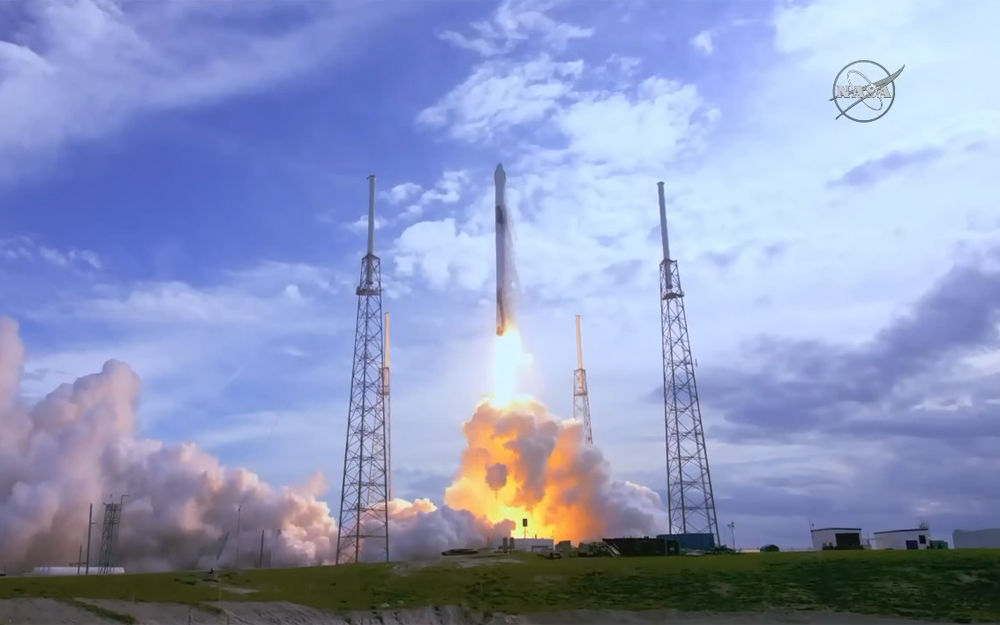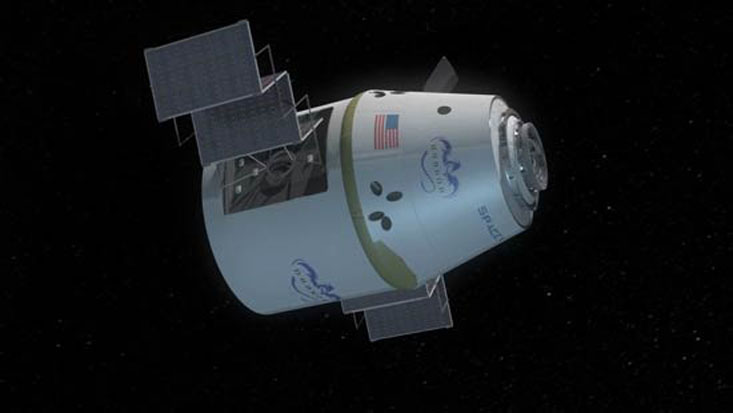Used SpaceX Dragon Launches NASA Cargo to Space Station on Pre-flown Rocket
SpaceX launched a used Dragon cargo spacecraft on a return trip to the International Space Station (ISS) today (April 2). The pre-flown cargo vessel lifted off at 4:30 p.m. EDT (2030 GMT) from Florida's Cape Canaveral Air Force Station on a Falcon 9 rocket that has also been to space before.
This marks the second time SpaceX has reused both a rocket booster and a payload, and the 14th cargo mission the company has launched to the ISS under its Commercial Resupply Services (CRS) contract with NASA. The first flight with a refurbished rocket and cargo craft, CRS-13 — which launched on Dec. 15, 2017 — was SpaceX's most recent cargo mission to the ISS.
So far, the company has launched 10 pre-flown Falcon 9 boosters on orbital missions, Jessica Jensen, SpaceX's Dragon mission manager, said in a prelaunch news conference yesterday (April 1). "What's neat about this is that it's becoming the norm," Jensen said. [The Most Exciting Space Missions to Watch in 2018]

The Dragon spacecraft that launched today also flew cargo to the ISS in April 2016, and the Falcon 9's first stage launched on the CRS-12 mission in August 2017. While the booster stuck an upright landing at SpaceX's "Landing Zone 1" at Cape Canaveral after its first launch, SpaceX did not attempt to land the booster today.
Loaded with 5,800 lbs. (2,630 kilograms) of supplies and science experiments for the Expedition 55 crew, the Dragon cargo craft is scheduled to arrive at the ISS Wednesday (April 4) after a two-day orbital chase.
As the spacecraft approaches the ISS, Japanese astronaut Norishige Kanai and NASA astronaut Scott Tingle will use the station's Canadarm2 robotic arm to grapple the spacecraft and tug it to the Harmony module, NASA officials said in a statement. Kanai and Tingle will capture the Dragon at approximately 7 a.m. EDT (1100 GMT) Wednesday, if all goes according to plan.
You can watch live coverage of the Dragon's arrival here at Space.com starting at 5:30 a.m. EDT (0930 GMT), courtesy of NASA TV. After the spacecraft has been captured, NASA TV will resume live coverage of its installation in the Harmony module at 8:30 a.m. EDT (1230 GMT).
Get the Space.com Newsletter
Breaking space news, the latest updates on rocket launches, skywatching events and more!
The Dragon will remain at the ISS until May, when the Expedition 56 crew will ship it back to Earth. It will splash down in the Pacific Ocean off the coast of Baja California, Mexico, with about 3,900 lbs. (1,800 kg) of cargo, SpaceX officials said in a statement. Expedition 55/56 crewmembers will therefore have about a month to unload and repack the Dragon before its scheduled departure.
Stuffed with science
About half of the cargo inside the Dragon will support 50 of the 250 science experiments that the Expedition 55 crew are conducting aboard the ISS. "This flight delivers scientific investigations looking at severe thunderstorms on Earth, the effects of microgravity on production of high-performance products from metal powders, and growing food in space," NASA officials said in a statement.
One experiment, the Atmosphere-Space Interactions Monitor (ASIM), is a small Earth-observation facility that will study severe thunderstorms and upper-atmospheric lightning from an external platform at the ISS, outside the European Space Agency's Columbus module. "ASIM advances understanding of the effect of thunderstorms on Earth's atmosphere, helping to improve atmospheric models and meteorological and climatological predictions," NASA officials said in the statement.
Another piece of scientific equipment heading to the ISS will provide a new test bed for all kinds of research on subjects ranging from plants and fruit flies to protein crystals and cell cultures. This "Multi-use Variable-g Platform" has built-in carousels that can produce up to 2 Gs of artificial gravity, or two times the pull of Earth's gravity, according to NASA's description.
Edible plants growing aboard the ISS will also receive an upgrade with the new Veggie PONDS experiment, which "uses a newly developed passive nutrient delivery system … to cultivate lettuce and mizuna greens, which are to be harvested on-orbit, and consumed, with samples returned to Earth for analysis," according to the Veggie PONDS experiment description.
These are only a few examples of the many science experiments heading to the ISS aboard this Dragon cargo mission. You can read about more experiments on CRS-14 here.
What's next for SpaceX?

SpaceX plans to launch its next space station cargo delivery, CRS-15, in June. Before then, its next Falcon 9 launch will send NASA's new Transiting Exoplanet Survey Satellite into orbit on April 16.
Though the company originally signed a contract with NASA to fly 12 cargo resupply missions to the ISS, NASA has extended the contract to include up to 15 flights. NASA has since issued a second contract, CRS2, covering additional private cargo missions between 2019 and 2024.
Email Hanneke Weitering at hweitering@space.com or follow her @hannekescience. Follow us @Spacedotcom, Facebook and Google+. Original article on Space.com.
Join our Space Forums to keep talking space on the latest missions, night sky and more! And if you have a news tip, correction or comment, let us know at: community@space.com.

Hanneke Weitering is a multimedia journalist in the Pacific Northwest reporting on the future of aviation at FutureFlight.aero and Aviation International News and was previously the Editor for Spaceflight and Astronomy news here at Space.com. As an editor with over 10 years of experience in science journalism she has previously written for Scholastic Classroom Magazines, MedPage Today and The Joint Institute for Computational Sciences at Oak Ridge National Laboratory. After studying physics at the University of Tennessee in her hometown of Knoxville, she earned her graduate degree in Science, Health and Environmental Reporting (SHERP) from New York University. Hanneke joined the Space.com team in 2016 as a staff writer and producer, covering topics including spaceflight and astronomy. She currently lives in Seattle, home of the Space Needle, with her cat and two snakes. In her spare time, Hanneke enjoys exploring the Rocky Mountains, basking in nature and looking for dark skies to gaze at the cosmos.









